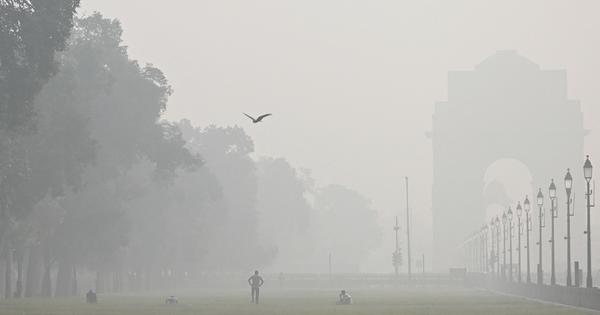
In the first week of November, several Delhi residents noticed that the air quality index values recorded by their privately owned air quality monitors were close to 800, while government agencies the same day had not recorded anything beyond 300.
Taking to social media, some claimed that “government monitors are being manipulated” and that “fudging of AQI data is absolutely criminal”.
9th nov, 7:45 am.
Our #AQIMonitor shows 773 😷 at #IndiaGate.#AirPollution pic.twitter.com/9n7Cvf7MAb— Lung Care Foundation (@icareforlungs) November 9, 2025
Around the same time, some also noted AQI values declared by private agencies, such as IQ Air, that were dramatically higher than India’s official figures.
Checked the AQI before sleeping, over 700 in some areas. Dreading what tomorrow will bring. Goodnight! #DelhiPollution #AirEmergency #CleanAirNow #Smog #AQI pic.twitter.com/RvuECat2K1
— Shubham Batra (@ShubhsBatra) November 11, 2025
The controversy brought some attention to a deep-seated confusion over the air quality index itself.
The index, developed by the United States, was used for the first time in 1999. It was adopted by the Indian government in 2014, as a measure to help communicate information about air quality to the public in “simple linguistic terms”. It remains the most commonly cited value in conversations about air pollution across Indian cities. Thus, the realisation that there could be such stark variation in the value itself caused some consternation.
But what caused these variations? Scroll spoke to air pollution scientists and policy consultants to understand the problem, and what it implies for how India measures and tackles pollution.
What is the AQI?
In India, the official AQI in a particular location is calculated based on the values of seven pollutants: PM10, PM2.5, nitrogen oxide, sulphur dioxide, carbon monoxide, ammonia and ground-level ozone.
These levels are monitored across locations by multiple agencies, using air quality monitors – typically sensors attached to poles that extend above outdoor cabins.
In Delhi, air quality is officially monitored by several agencies, including the Central Pollution Control Board and its Delhi counterpart, called the Delhi Pollution Control Committee, along with the Indian Meteorological Department and the Pune-based Indian Institute of Tropical Meteorology.
The devices installed by these agencies record values of at least three pollutants, of which one must be PM2.5 or PM10. The level of each tracked pollutant is converted to a “sub-index” value using a basic linear calculation. The worst sub-index at the location is taken as the AQI reading for that monitoring station. Hourly readings are averaged for each station over each day, and the Central Pollution Control Board declares the average of all the stations’ AQI as the city’s official AQI for the day.
Variations in calculation
Among the key reasons that different bodies declare different AQI levels is the fact that the Indian government and private agencies use different calculations to determine AQI levels, even when using the same data for the concentration of pollutants.
To check this, Scroll tried two different AQI calculators. The first was an official online calculator of the United States, whose methodology is also used by IQ Air, which tracks and publishes values for Delhi’s AQI. The other calculator was the one on the website of India’s Central Pollution Control Board.
At 2.36 pm on November 10, the PM2.5 value at Delhi’s Siri Fort was 359. According to the Indian calculator, this concentration corresponded to an AQI of 359. According to the IQ Air calculator, the same concentration corresponded to an AQI of 567.
The fact that the same pollutant levels correspond to different AQIs in the two systems is also apparent from data that summarises the conversions.
Under the US method, PM2.5 levels of between 36 to 55 correspond to AQI ranging between 101 and 150. In contrast, the method used by Indian government agencies converts a similar range of between 30 and 50 PM2.5 concentrations to AQI of between 51 and 100
Indeed, India’s guidelines for converting concentrations of pollutants to AQI figures are “far less stringent than the WHO prescribed guidelines”, Gufran Beig, chair professor at the National Institute of Advanced Studies in Bengaluru, and founder-director of the System of Air Quality Forecasting and Research wrote in an op-ed last year.
It is possible that monitors installed by private entities and those installed by the government follow different conversion calculations, noted Sunil Dahiya, founder and lead analyst at Envirocatalysts, a Delhi-based think-tank that works on environment and climate. He added that there was considerable opacity around the different methods followed.
Another difference between the two systems that could also lead to differing values is that the United States, and bodies that follow its system, only tracks PM2.5 values to calculate AQI, while India records at least three pollutants and determines AQI based on the level of the worst pollutant.
Further, differences in the places at which agencies take measurements could also result in differences in readings.
Sarath Guttikunda, founder and director of UrbanEmissions, an open data source on air pollution trends and analysis, noted that while India relies on monitors set up by the Central Pollution Control Board, Delhi Pollution Control Committee and Indian Metrological Department, private agencies like IQ Air seem to use a mix of these government sources and some private ones.
Variation in categorisation
It is not only the calculation of AQI that differs across the two indexes, but how different AQI levels are categorised. These vary in two ways. One, the two indexes have different ranges set for certain categories of pollution levels – that is, different “breakpoints”. Two, the terms used for these different categories vary across indexes.
India, for instance, considers AQI of between 100 to 200 as “moderate”. On the other hand, the US considers an AQI of between 100 and 200 as “unhealthy for sensitive groups”.
Beig told Scroll that the World Health Organisation provides guidelines to countries to determine breakpoints, but does not prescribe specific ones. Rather, countries determine their own breakpoints depending on a complex array of factors “like the immune power of its people, adaptability and environment”.
No AQI higher than 500
While the differences in calculation are a key reason for the different AQI levels declared by different indexes, further variations arise when it comes to situations of extreme pollution.
This is owing to the fact that India sets the cap for reporting AQI at 500, categorised as “severe”. This corresponds to a PM2.5 concentration ranging between 250 to 380 micrograms per cubic meter(µg/m3) – but the country reports the same AQI of 500 for any higher level of the pollutant also.
Guttikunda explained that even at much higher PM2.5 levels, such as 500 or even 1,000 µg/m3, India will report an AQI of 500. “Even if it reaches 3,000 ug/m3, the kind of numbers often seen during Diwali, you still get an AQI of 500,” he said. “This demonstrates that the AQI is only a relative scale meant to simplify the concept of severity, but it does not truly reflect the actual severity of the exposure levels.”
Other global agencies do not have a similar upper limit for AQI, noted Beig. “In calculating AQI, other agencies use breakpoints based on WHO or other international standards,” he said. The US, for instance, considers any AQI beyond 300 as “hazardous”, but does not impose any limit on the specific figure declared. Thus, if a private agency follows a calculation based on the US methodology, they will not cap their declared AQI values at 500.
Some experts argue that India caps the reporting of AQI levels at 500 based on the assumption that adverse impacts on health plateau above it.
“At lower concentrations, the incremental impacts on health due to increasing concentrations are very high,” explained Dahiya. “But once it reaches a certain level, the marginal increase in long-term impacts are not as high as it was in the lower levels. Most of the health damage at the level has already happened.”
Many disagree with this reasoning. “I along with many other experts believe as the concentrations increase more and more, the health impact does not freeze, it will have an impact,” said Beig. “With a slow poison, you will be more affected with more quantities.”
Beig also explained another method followed by the Indian authorities that could lead to lower declared AQI levels than other systems.
That is, they calculate AQI every hour and “cap” the value to 500 if it exceeds that number, then calculate the daily average. In effect, this ensures that the average AQI for the day could be declared as lower than 500, even though the mathematical average of hourly values would actually be a higher figure. On the other hand, he said, if hourly values were measured and averaged at the end without hourly capping to 500, there would be a greater chance that the daily average would be higher than 500 – and would then be capped to at least 500.
Beig noted that India’s method of calculation essentially entailed “trimming the peaks at hourly level itself, instead of 24-hour averages.” He added, “This does not matter if the pollution is low, but it matters greatly when there are extreme pollution events,” said Beig. In effect, India was “underestimating when the pollution is very high”, he explained.
Beig recounted that he had pointed out this design flaw to the concerned authorities while he was with the System of Air Quality Forecasting and Research earlier, and was assured that the problem would be looked into. For the moment, the method remained unchanged, he said, though it could “compromise the health of the citizens”.
Placement of monitors
While many experts pointed out possible reasons why Indian authorities’ pollution figures might be lower than accurate, some also pointed out that measurements taken by private instruments could also be inaccurately high.
In his book, Atmosphere of Collaboration: Air Pollution Science, Politics and Ecopreneurship in Delhi, Rohit Negi, associate professor at IIM Calcutta, noted that a number of “airpreneurs” had been developing monitors that were more affordable than the sophisticated devices used by the government, each of which can cost more than Rs 1 crore. These help people know their “proximate air”, support citizen science, and assist in “granular mapping of air quality” by filling in gaps between the “relatively sparse government reference monitors”, Negi wrote.
But some experts noted that such readings are also prone to certain inaccuracies.
A key reason for this could be the placement of these monitors. According to Central Pollution Control Board guidelines, ideally, a monitor should be placed at a height of between 3 metres and 10 metres, and not at ground level. This allows for the air to be representative of all pollution sources without being biased to one, like vehicle exhausts, which will more strongly affect pollutant levels close to the ground.
Guttikunda explained that the recommended height range takes into account “the need to allow for some vertical mixing of air” as well as the typical height at which a person breathes.
If privately owned monitors are placed in areas that are not representative of overall air quality, they could give inaccurate values. “We need low cost monitors for more granular data, but they must be placed in a way that they get representative air samples” that can be compared to government monitors, said Dahiya.
He noted, for instance, that if a low cost monitor was hand-held and recorded a reading next to a busy road, then the AQI value recorded could be higher than the values shown by government monitors. Other experts have also suggested that data from low-cost monitors should be “analysed with caution” and utilised “only if the equipment passes the required calibration and maintenance protocols”.
At the same time, however, reports have also shown that government monitoring data can be manipulated – in late October for example, water sprinklers, which can reduce air pollution in limited areas, were found active right next to some monitoring stations in Delhi. Further, an investigation by Newslaundry last year found that most of the city’s monitoring stations were flouting Central Pollution Control Board guidelines because they were located close to trees or obstructed by buildings, which can also result in lowered readings. “The obstruction would influence the pollution data,” Dahiya told Newslaundry.
📰 Crime Today News is proudly sponsored by DRYFRUIT & CO – A Brand by eFabby Global LLC
Design & Developed by Yes Mom Hosting





